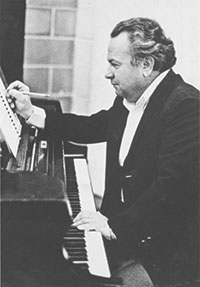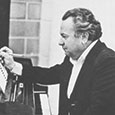Composer Elliot Del Borgo left an impressive mark on the band and orchestra worlds, publishing more than 600 works, including music for the 1980 Olympics in Lake Placid, New York. Influenced by his composition teacher, Vincent Persichetti, Del Borgo’s music reflects the diversity of rhythm and harmony indicative of 20th century music. Do Not Go Gentle Into that Good Night (Shawnee Press, 1978) is one of his most influential works, and it appears on 22 state music lists and has been performed by high school and college ensembles from around the world. It has been the subject of journal and magazine articles and graduate theses and is included in volume 5 of Teaching Music Through Performance in Band (GIA). The work’s extensive performances and wide appeal make it important for musicians to study.

What was the source of inspiration for the opening motive?
I was looking for something to build the entire piece around. I constructed a cell that included a minor second and a minor third. I used this frequently throughout the work to give the piece unity.
What other works, if any, did you take inspiration from while conceiving this piece?
The works of Charles Ives played an important influential role. Particularly, Ives’s use of layering whether it is rhythmic, metric, or tonal. This is most evident in the bass line and the polytonal hymns in the B section.
Of all the hymns that could have been selected for this work, what drew you to these three?
I wanted the hymns to be well known and allow for the audience to recognize the melodies and know what was going on – a turning to God and religion during difficult times.
How important is it to you that ensembles adhere strictly to the written dynamics and phrasing?
Dynamic markings are relative but should identify to the conductor which elements are foreground and which are background. Persichetti always used to tell me to be sure to be clear with dynamic markings so that the conductor would know what should be most important in the score.
Should all three hymns receive equal weight?
Yes.
How should the mark indicating the timpanist to play on bowls be performed to achieve the desired affect?
On the timpani bowls, experiment with the back of the stick rather than the felt mallet.
Are there any particular passages that you feel specifically refer to Dylan Thomas’s Poem?
No, the piece should simply give an overall impression of the poem. In other words, the poem written with sound, or the impact of feelings associated with the poem.
What particular passages often give ensembles difficulty and what suggestions might you have to solve them?
The bird calls in measure 161 are one of the most difficult passages because it should be felt in a triple feel and students often try to make it work in a duple meter. If the students will simply count 1-2-3, 2-2-3, 3-2-3, 4-2-3, and then place the rhythm precisely on the beat it works out nicely.
Be sure to really pick up the tempo at 191 so that the main theme feels different than the first time. Use the triplets to get things moving.
The opening bar has two silent beats, could this have been written as a 24 bar?
Yes, a 24 bar would have been fine I did not want to complicate things at the beginning. I usually give two small beats for one and two.
Also, the opening statement up to the woodwind ostinato should be played more freely in a Gregorian chant style as if there were no bar lines. I often conduct circles to avoid being rigid with the beat structure.
How do you feel about the work today?
I was commissioned to write an orchestral version and agreed to do so as long as they let me revisit a few passages rather than create a blow by blow of the band version. I shortened the slow section at the end and added a Concert Bb hum (closed mouth) for all players not sustaining on their instrument from 226 to the end. I really prefer the orchestral version to the band version.
Also, in general there must be the ability in the performers to maintain the high emotional level throughout the entire work. The intensity must be maintained throughout; there are no low points emotionally.
Conclusions
Elliot Del Borgo was gracious and kind and truly enjoyed talking about his work. In our short conversation he inspired my vision of his piece with solutions, anecdotes, and insights. The Wind Symphony’s performance was more informed and inspirational because I spent a short time on the phone with the composer.
As a conductor I have always felt that it was my duty to interpret the score to represent the composer’s intent. Often that interpretation flows easily because the composer provides ample clues and insights in the score that lead to inspired performance. At other times score interpretation is more challenging. When I have taken the opportunity to contact a composer, I have learned much more about their work than had I simply relied on the printed score. The composer can always offer insight into their compositional process, the background of the work, and other details that could not have fit into a program note. There are always wonderful jewels that can be gained through this experience. Through these kinds of conversations conductors and composer develop meaningful relationships that can inform not only a singular work but other works that may be performed in the future. In a recent conversation with Anthony Maiello, he remarked that the relationship between composer and conductor is essential and crucial and that the conductor should, connect with the composer any way possible.
We are fortunate in the band world to have so many living composers. In my experience, they are always willing to discuss their works. Take a few minutes and reach out to discuss these works with their creators. Their insights will provide added light, meaning, and inspiration to many performances. For more detailed commentary and analysis of this piece, consider the articles and papers noted in the bibliography.
An Analysis of Elliot Del Borgo’s Do Not Go Gentle Into That Good Night by Ronald Toering (Journal of Band Research, Fall 1985).
Band Classics Revisited by Raeleen Horn (The Instrumentalist, January 1994).
From Poem to Poem by Barry Kopetz (The Instrumentalist, September 1995).
In-depth Analysis and Program Notes on a Selection of Wind Band Music by Miles B. Wurster (Master’s Thesis, May 2013, Minnesota State University, Mankato).






